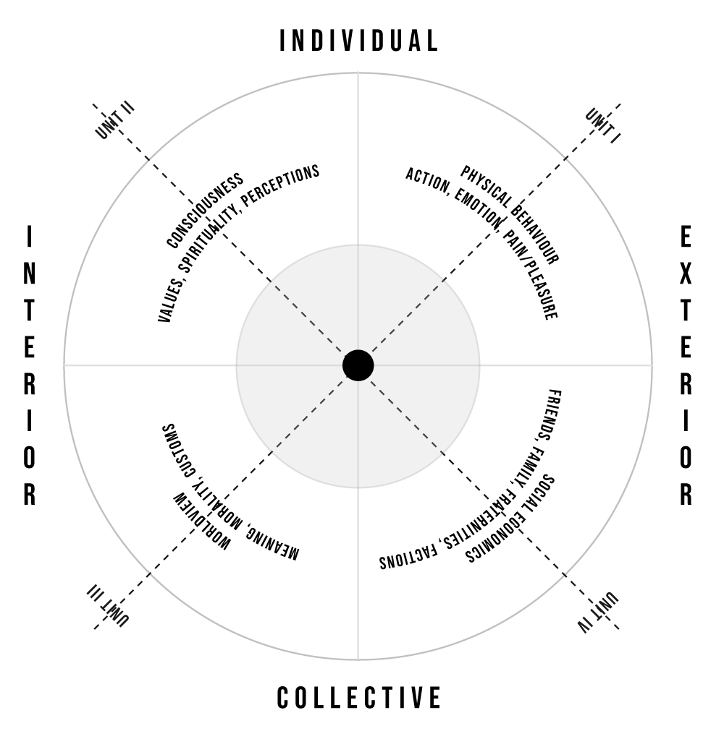Note: Fall 2023 did away with this Unit breakdown though the weekly material for in-person classes still follows this conceptual flow. The week numbers in [brackets] offers the current move through these elements.
Note: Fall 2025 moved away from this model and to a concentric person-oriented model. I have not written a detailed breakdown of how that works, but some of this leftover information can still be seen if you squint hard enough.
I think it’s important to understand the basis of an examination. In this case, I want you to understand the basis for how I have designed and laid out this course. I think it will make all the difference in seeing the material and how it relates best to your own self, personality, and place in the bigger picture.
One of the first things that you should notice about the course is that we do not progress through the textbook in a sequential manner, that is, we don’t go through it chapter by chapter from the front to the back. I find the material to be incongruent with lived experience. I admit we skip a chapter or two mostly due to time constraints and the desire to focus on the human condition itself and not get lost in the minutiae.
Next, you’ll see that we have a total of six units—labeled Unit 0 through Unit 5. I will explain each one as it relates to the overall design of this course.
Unit 0: Laying the Foundations [Weeks 2-3] is foundational materials—specifically, history and research methods. I think it is important to take a brief tour through the history of psychology if only to see where we’ve been but where we’re going. In classes that have an in-person component, I typically offer (when time permits) a lecture, Silent Voices of Psychology, in which we explore more acutely the contributions of women and other minorities. It tends to offset the focus on dead white guys the textbook seems obsessed with exploring almost to the exclusion of any others. Eventually I’ll have a recorded lecture for my online classes as well.
Unit 5: The Ascension of the Machine [Week 16] is considered “Finals Week”—though in some classes this is the final two calendar weeks of the course. Here you will submit a self-reflective paper based on some prompts I offer and then you will write an introspective discussion board post. I have yet to give anyone less than full points for these unless the material was just entirely ignored. It is an entirely subjective exercise and designed for you to look at everything you’ve learned for the semester and put it into a self-perspective.
But what about the four units between Unit 0 and Unit 5 .. what are those?
My particular theoretical orientation (both as a professor and a psychologist) stems from an integral or transpersonal perspective. As such, I believe that every individual is “made up of” or can be explored through four aspects or validity domains: objective, subjective, intersubjective, and interobjective. This translates into biological, psychological, cultural, and systemic respectively. While there is certainly some overlap in areas (such as life span development, as an example, which overlaps both biological and psychological aspects of ourselves), the subjects we explore in this class fit pretty nicely into these four areas. However, the textbook itself does not present this material in quite this way, so I have taken the liberty of jumping around the textbook.

Let’s take a look at these four units now.
Unit 1: The Machine [Weeks 4-6] is a baseline look at our objective state (upper right quadrant), the biological and behavioral aspects of ourselves. We define objective as that which we can touch or measure. You might say this is the “outside” of everything we are but not merely physical objects. While it would cover the brain, it also covers behavior—though it does not cover motivation to behavior. This latter aspect would fall under ethics which we find in socio-cultural aspects of the human condition.
Unit 2: The Ghost in the Machine [Weeks 7-11] explores our psychological state (upper left quadrant) in which we explore consciousness, altered states such as dreaming, meditation, and even psychoactive drugs. This is the subjective aspect to our existence. It is the “inside” of ourselves, that which we cannot measure adequately: consciousness, the mind, some motivations, personality, and even intelligence itself. In explaining the grey areas between these quadrants, intelligence is a good example of something that we claim we can measure—using IQ Tests and the like—but eludes our precise measurements by being in a constant state of flux.
Unit 3: The Emergence of the Machines [Weeks 12-14] examines several broader cultural aspects of our lives (lower left quadrant), specifically sexual orientation and gender development. There is also the addition of a topic that isn’t covered as fully in the text: politics and religion from a psychological perspective. These are elements that are culture bound and yet (following the understanding of these grey areas) have a basis in reproductive advantage (biology). We don’t think of politics or religion being inherited or useful for survival of the species and yet they both are intrinsic to the human condition.
Unit 4: The Rise of the Machines [Week 15] takes a look at our systemic or structural aspects (lower right quadrant) as we explore groupthink, prejudice, and racism in this final unit. For in-person classes, I offer a lecture on the psychobiosocial review of the Nature of Evil. I hope to have a recorded lecture over the subject for online classes in the near future.
When you are done with this course, you should have a 360° look at yourself. It will be a basic look, for sure, as this is a General Education course and not an in-depth course about any one area of the human condition. If you move forward with a degree in psychology, you will have further classes that delve far more deeply into each of these areas. My goal is to offer you a taste of psychology as a whole. My objective is to do that in a manner that makes sense when all is said and done.
